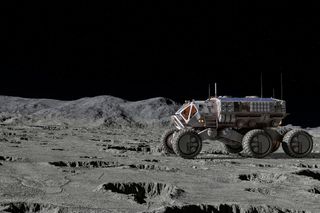
Getty Images
Lonnie Johnson holds his patent for the pump-action water gun he developed, now known as the Super Soaker
Topics: African Americans, Black History Month, Diversity in Science, Mechanical Engineering, NASA, Nuclear Engineering, STEM
Engineer Lonnie Johnson invented the massively popular Super Soaker water gun and is developing a thermoelectric device to convert solar energy into sustainable power.
Lonnie Johnson invented the Super Soaker in 1989 and has since dedicated his engineering skills to creating more efficient rechargeable batteries and sustainable solar power. As a child, Johnson learned to build toys from his father and was later inspired to make a career of his early talent by fellow Black inventor George Washington Carver. Since the debut of Johnson’s famous toy, hundreds of millions of Super Soakers have been sold, and the water gun was added to the National Toy Hall of Fame in 2015. Seven years later, Johnson was inducted into the National Inventors Hall of Fame. Today, in addition to working on batteries, the inventor and his team are developing the Johnson Thermoelectric Energy Converter (JTEC), an engine that converts heat from solar energy into electricity more effectively than current technology.
Lonnie George Johnson was born on October 6, 1949, in Mobile, Alabama. His father was a World War II veteran who worked as a civilian driver at nearby Air Force bases, while his mother worked in a laundry and as a nurse’s aid. During the summers, both of Johnson’s parents also picked cotton on his grandfather’s farm.
Out of both interest and economic necessity, Johnson’s father was a skilled handyman who taught his six children to build their own toys. When Johnson was still a small boy, he and his dad built a pressurized chinaberry shooter out of bamboo shoots. At age 13, Johnson attached a lawnmower engine to a go-kart he built from junkyard scraps and raced it along the highway until the police pulled him over.
Out of both interest and economic necessity, Johnson’s father was a skilled handyman who taught his six children to build their own toys. When Johnson was still a small boy, he and his dad built a pressurized chinaberry shooter out of bamboo shoots. At age 13, Johnson attached a lawnmower engine to a go-kart he built from junkyard scraps and raced it along the highway until the police pulled him over.
Growing up in Mobile in the days of legal segregation, Johnson attended Williamson High School, an all-Black facility, where he was told not to aspire beyond a career as a technician despite his precocious intelligence and creativity. Nevertheless, inspired by the story of famed African American inventor George Washington Carver, Johnson persevered in his dream of becoming an inventor.
Nicknamed “The Professor” by his high school buddies, Johnson represented his school at a 1968 science fair sponsored by the Junior Engineering Technical Society (JETS). The fair took place at the University of Alabama at Tuscaloosa, where, just five years earlier, Governor George Wallace had tried to prevent two Black students from enrolling at the school by standing in the doorway of the auditorium.
The only Black student in the competition, Johnson debuted a compressed-air-powered robot, called “the Linex,” which he had painstakingly built from junkyard scraps over a year. Much to the chagrin of the university officials, Johnson won first prize. “The only thing anybody from the university said to us during the entire competition,” Johnson later recalled, “was ‘Goodbye’ and ‘Y’all drive safe, now.’”
After graduating with Williamson’s last segregated class in 1969, Johnson attended Tuskegee Institute (today Tuskegee University) on a scholarship. He earned a bachelor’s degree in mechanical engineering in 1973, and two years later, he received a master’s degree in nuclear engineering from the school.
After Johnson received his degrees, he joined the U.S. Air Force and became an important member of the government's scientific establishment. He was assigned to the Strategic Air Command, where he helped develop the stealth bomber program. Johnson moved on to NASA’s Jet Propulsion Laboratory in 1979, working as a systems engineer for the Galileo mission to Jupiter and the Cassini mission to Saturn, before returning to the Air Force in 1982.
Despite his busy days, Johnson continued to pursue his [own] inventions in his spare time. One of his longtime pet projects was an environmentally friendly heat pump that used water instead of Freon. Johnson finally completed a prototype one night in 1982 and decided to test it in his bathroom. He aimed the nozzle into his bathtub, pulled the lever, and blasted a powerful stream of water straight into the tub. Johnson’s instantaneous and instinctive reaction, since shared by millions of kids around the world, was pure delight.
In 1989, after another seven years of tinkering and tireless sales-pitching, during which he left the Air Force to go into business for himself, Johnson finally sold his device to the Larami Corporation. The “Power Drencher” initially failed to make much of a commercial impact, but after additional marketing efforts and a name change, the “Super Soaker” became a massively successful item. It topped $200 million in sales in 1991 and went on to annually rank among the world’s top 20 best-selling toys.
Dr. Lonnie G. Johnson, Biography dot com
